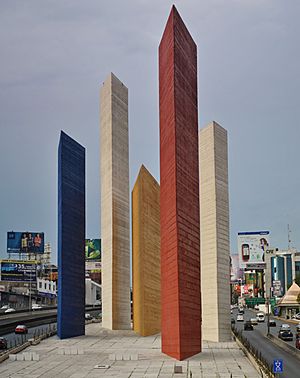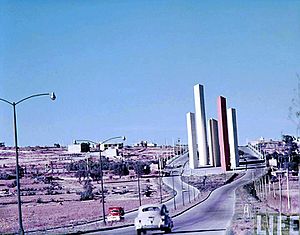Ciudad Satélite facts for kids
Quick facts for kids
Ciudad Satélite
|
|
|---|---|
|
Neighborhood (Fraccionamiento)
|
|

Torres de Satélite landmark
|
|
| Nickname(s):
Satélite
|
|
| Country | Mexico |
| State | State of Mexico |
| Municipality | Naucalpan de Juárez |
| Government | |
| • Body | Asociación de Colonos de Ciudad Satélite |
Ciudad Satélite (lit.transl. Satellite City), often called Satélite, is a well-known neighborhood in Naucalpan, Mexico. It is located about 14 kilometers (9 miles) northwest of Mexico City's historic center. The name "Ciudad Satélite" officially refers to the original neighborhood, which was founded around 1957.
Over time, the name "Satélite" has grown to include nearby areas. These include neighborhoods like Lomas Verdes and San Mateo. It also covers parts of the nearby municipalities of Atizapán de Zaragoza and Tlalnepantla de Baz. This wider area is known for being a lively place both economically and socially.
Satélite was first planned as a "city outside the city." It was meant to help with the growing population of Mexico City. It became one of Mexico's most important building projects in the 20th century. Architects Mario Pani and José Luis Cuevas Pietrasanta designed it. It quickly became popular for people who wanted to live outside the main city.
Contents
What is Ciudad Satélite?
Satélite was first designed as a satellite city. This means it was a community where people would live and then travel to Mexico City for work. Developers hoped to keep a green area between Satélite and Mexico City. However, the area grew very quickly, and property prices went up. This made it hard to keep the green spaces.
Despite this, Satélite became a cultural hub. It grew to include not just houses, but also apartment buildings and shops. Some factories also developed there. This was different from the original plan. Over the years, the growth of new buildings has changed what "Satélite" means to people in Mexico City.
The project was approved by President Miguel Alemán Valdés in 1948. People started moving in around 1952 because the prices were good. At first, public services like phone lines were not ready everywhere. People had to use public phones. By the 1970s, many more people lived in Ciudad Satélite.
Because of its fast growth, new neighborhoods were built. These are now seen as part of the Satélite area. Some of these include Las Américas, Vista del Valle, and Paseos del Bosque. Other neighborhoods like San Mateo and La Florida are also considered part of Satélite.
History of Satélite

Not much is known about the area before the Spanish arrived. The Tlatilca culture once lived near the Totolinga, Los Cuartos, and Hondo rivers. Later, during the time of Spanish rule, the Shrine of Our Lady of Los Remedios was built. This happened after a Spanish officer found a religious statue under a maguey plant. The shrine was built in the 1500s. Nearby are the "snail" towers of the Los Remedios Aqueduct.
Ciudad Satélite began as a new city idea in the mid-1950s. Mexico City was growing fast, and a new middle class was emerging. This led to the need for new neighborhoods. The land for Ciudad Satélite was once owned by Mexican President Miguel Alemán Valdés. Architect Mario Pani created most of the city's design.
A special feature of Ciudad Satélite is its street design. It has no traffic lights. Instead, it uses wide oval roads called "circuitos" (circuits). These circuits connect to other main roads. This design helps drivers see oncoming cars easily. Each circuit in Ciudad Satélite has streets named after famous professionals. For example, there are circuits for Sculptors, Painters, Musicians, and Scientists.
The city was planned with different areas for middle, upper-middle, and high-class residents. Some circuits, like Novelists and Economists, had higher land prices. This is where the largest and most impressive houses were built.
Many houses in Ciudad Satélite were built in a functionalist style. This means they had simple designs with few decorations. The large San Felipe de Jesús Sanctuary, often called Ciudad Satélite's cathedral, also shows this style. Other building styles in the area include colonial and modernist.
As Satélite grew, it faced some challenges. These include heavy traffic because many people drive to Mexico City for work. Some roads are also getting old. New buildings have also led to more homes than needed in some areas.
Famous Sights
You can see some of the area's old history at the Our Lady of Los Remedios Shrine and its aqueduct.
The Torres de Satélite (Satellite Towers) are a famous landmark. They stand in the middle of Periferico, Mexico City's main highway. Mathias Goeritz and Luis Barragán designed these towers. They are an important example of modern sculpture and architecture. In the late 1990s, they were repainted in their original colors.
Naucalli Park is a large forest of eucalyptus trees. It is a popular place for locals to relax and have fun. The park has a jogging path, playgrounds, and fountains. It also has a convention center, an art exhibit area, and a culture house. You can find an archery training ground and a large stage for music concerts there. There is even an amusement park with animatronic dinosaurs.
Plaza Satélite is one of the biggest malls in Mexico City. It was built in the late 1960s. The mall has large department stores, music shops, restaurants, and a big movie theater. It has been updated twice since it was built.
Mundo E is a smaller mall. It has shops, a movie theater, a fitness center, and nightclubs. Other smaller malls include Heliplaza. A new large mall called La Cúspide (The Summit) was built on the highest ground in the area. It offers great views of Mexico City.
The Mall Circuit Zone (Circuito Centro Comercial) is the main shopping area of Satélite. Besides the big mall, it has many businesses. These include restaurants, nightclubs, coffee shops, bookstores, and banks.
The Blue Zone (La Zona Azul) has some of the first businesses in the area. It is a famous spot in Satélite. People often gather there to celebrate after the Mexico national football team wins a game. A popular ice cream and spicy fruit shop is a main attraction.
The Ruins of Acropolis were meant to be an outdoor shopping mall. However, it was never popular and was left empty. Today, it is a well-known landmark in Ciudad Satélite.
Education, Culture, and Sports
Satélite has several private schools and a few public junior high schools. There are also university campuses here. These include the UNAM Faculty of Superior Studies at Acatlán and a Universidad del Valle de Mexico (UVM) campus.
Some of Mexico's Olympic medal winners have lived in Satélite. These include Carlos Mercenario, Soraya Jiménez, and Fernando Platas. The area also has fields for local sports teams. These include the Buccaneers, the Cowboys, and the Black Dogs. There is also a local soccer league called Liga de Fútbol Satélite.
Many famous artists and musicians come from Satélite. These include classical singer Rolando Villazón and members of the band Café Tacvba. The rock band DLD also has members from Satélite.
In the 1960s, a group called ARDECUSA was formed. Its name means "Art, Sport, and Culture of Satélite." This group helped improve cultural and sports life in Satélite. They organized theater plays, choirs, sports teams, and newspapers. The Coro Genesis choir was very famous and won many awards. ARDECUSA also put on many popular musicals like "Grease" and "Anything Goes."
See also
 In Spanish: Ciudad Satélite para niños
In Spanish: Ciudad Satélite para niños

